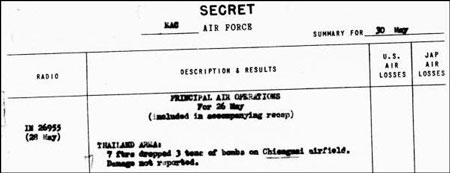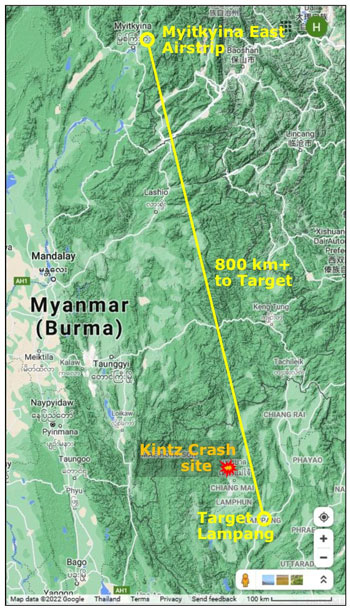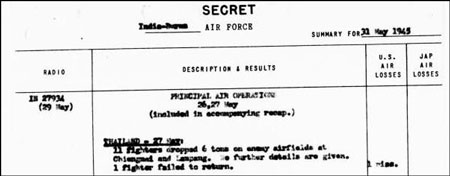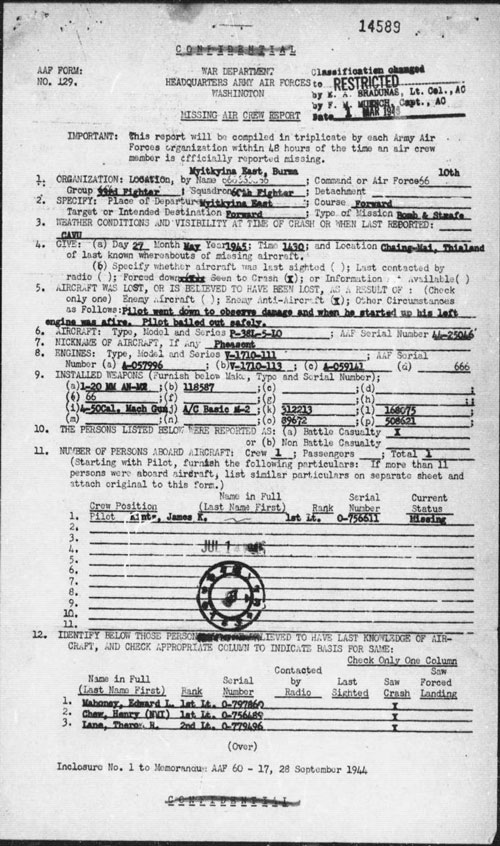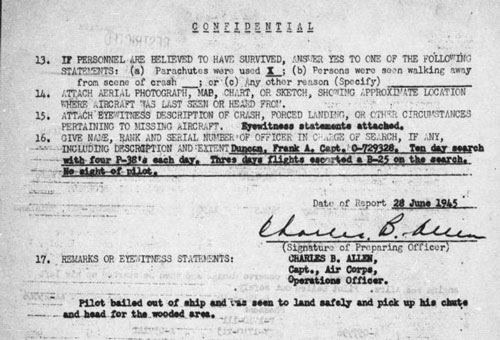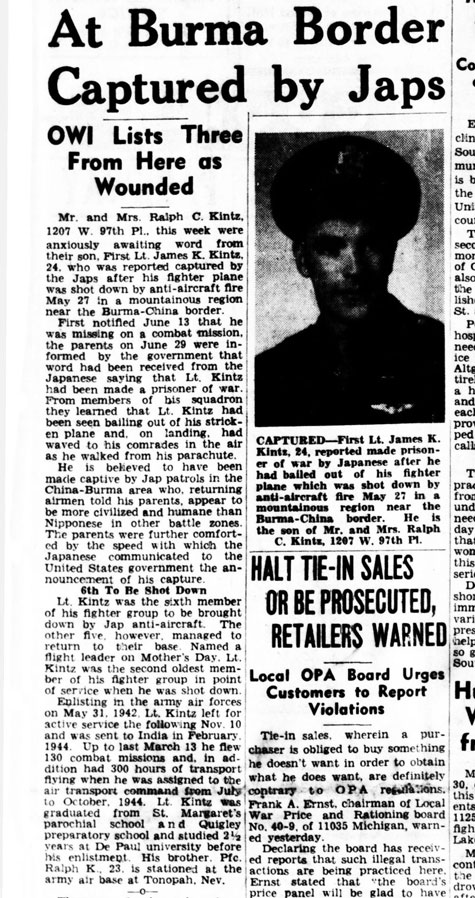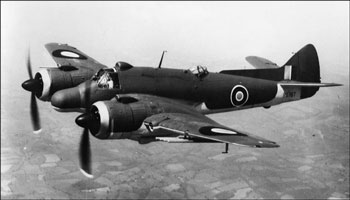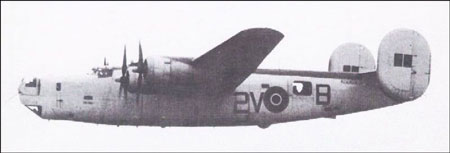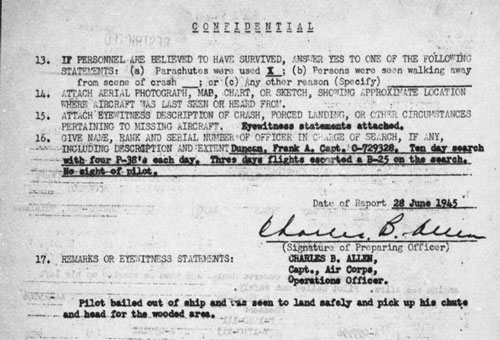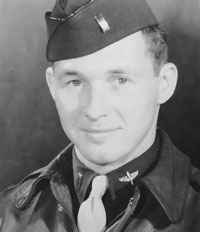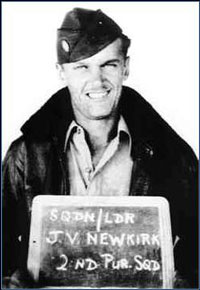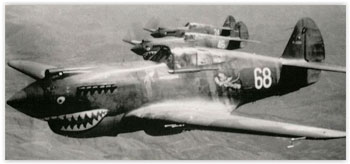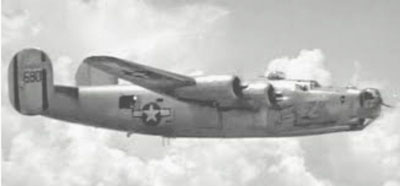27 May 1945: 1Lt James K Kintz was assigned to the 60th Fighter Squadron, 33rd Fighter Group, 10th Air Force, home based at the Myitkyina East field in northern Burma. There he flew a P-38,1
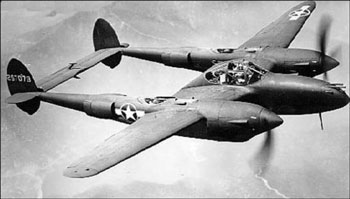 participating in numerous USAAF actions in the China-Burma theater. In Jan 1945, the Chicago Tribune summarized his experience: 2
participating in numerous USAAF actions in the China-Burma theater. In Jan 1945, the Chicago Tribune summarized his experience: 2
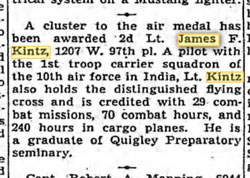 On 26 May 1945, he led a flight to bomb Chiang Mai Airfield: 3)
On 26 May 1945, he led a flight to bomb Chiang Mai Airfield: 3)
Principal Air Operations for 26 May
THAILAND AREA:
7 ftrs dropped 3 tons of bombs on Chiengmai airfield. Damage not reported.
The next day, 27 May 1945, he led a flight whose mission again included bombing Chiang Mai Airfield: 4
Transcription:
Principal Air Operations for 26, 27 May [1945] THAILAND – 27 May 11 fighters dropped 6 tons on enemy airfields at Chiengmai and Lampang. No further details are given. 1 fighter failed to return.
The fighter which “failed to return” was that of Kintz. From the Missing Air Crew Report (MACR) 14589,5
page 1:
Organization: 60th Fighter Squadron, 33rd Fighter Group, 10th Air Force, Myitkyina East, Burma
Date: 27 May 1945
Type of mission: Bomb and strafe
Circumstances: Pilot went down to observe damage and when he started up his left engine was afire. Pilot bailed out safely.
Aircraft: P-38L
Weapons: 4- .50 caliber Browning machine guns; 1-20mm AN-M2 cannon
Pilot: James L Kintz, 1Lt
MACR page 2: 6
Officer in charge of search: Duncan, Frank A, Capt, O-729328. Ten day search with four P-38s each day. Three days flights escorted a B-25 on the search. No sight of pilot.
Remarks of eyewitness: Pilot bailed out of ship and was seen to land safely and pick up his chute and head for the wooded area.
From page 3 of the MACR 14589, the first of three eyewitness statements read: 7
28 June 1945
On 27 May 1945, Lt Kintz led a twelve ship flight on a dive bomb mission into Thailand. I was flying number four position in the lead flight.
After bombing our target, the flight was reformed and climbed to 10,000 feet. About ten minutes after leaving the target, Lt Kintz called his number two man and told him to take the flight and keep on course for home while he went down to observe damage done on an airstrip bombed by our Squadron the day before.
The next thing I heard on the radio, Lt Kintz called his wingman to come down and take a look at his left engine as it was smoking. The remaining three ships of Lt Kintz’s flight started down and, as I spotted his ship first, I pulled away from the flight and went down and flew Lt Kintz’s left wing. His left engine was letting off large puffs of grey smoke which shortly turned into a steady stream of gray smoke slowly turning black.
Nothing that Lt Kintz may have done was of any use. Shortly after the smoke turned black Lt Kintz bailed out around 3,000 feet above the ground. The ship went into a slow diving turn and exploded upon contact with the ground. Lt Kintz’s chute opened and upon landing he gathered up the chute and started walking towards some trees that were at the edge of the rice paddy where he landed.
The flights then reformed and pin-pointed the location on the map and headed out on course for home. When radio contact could be made, a report of the accident was called in to Fighter Control at Bhamo.
THERON H LANE
2nd Lt, Air Corps
Pilot
A diary maintained by a Chiang Mai resident, Pastor Meungjai Chaninpan, recorded events during the period:8
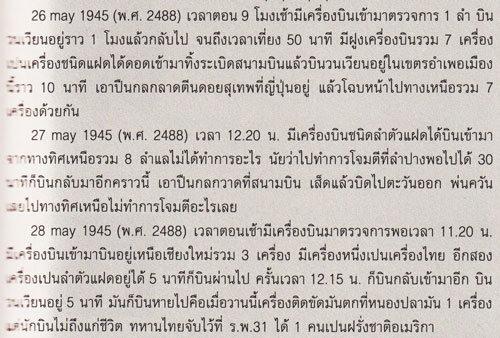 Translation: 9
Translation: 9
26 May 1945: at 9 am, enemy aircraft came to observe for one hour. At 12:50, seven twin engine aircraft came to bomb the airport; and, after that, flew around Amphoe Meaung area for about 10 minutes; then fired at Japanese at the foot of Suthep mountain, and finally flew away to the north.
27 May 1945: at 12:20, eight enemy aircraft passed Chiangmai to attack Lampang. Thirty minutes later they returned to fire on Chiangmai airport, then flew to the east and then on to the north.
28 May 1945 enemy aircraft came in the morning to observe; at 11:20, three aircraft flew above Chiangmai for five minutes, one of them a Thai airplane;* then they flew away; at 12:15 they returned to fly around for five minutes, then flew away. Yesterday one aircraft crashed at Nong Plaman, the American pilot survived and was arrested by Thai soldiers. He was put in Hospital 31.
A key item here is the naming of the location of Kintz’s parachute landing and crash site of his P-38: บานหนองปลาทัน (Nong Plaman).
A letter from the Acting Governor of Chiang Mai describes what happened on the ground (page 1): 10
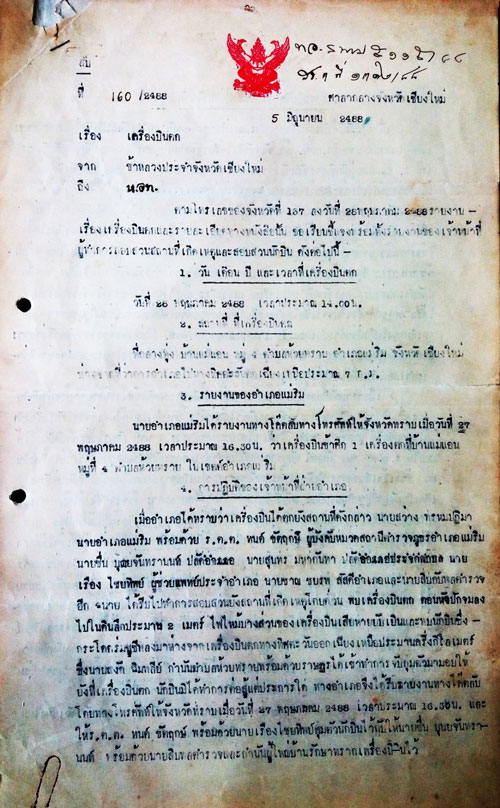 Translation of entire eight page letter: 11
Translation of entire eight page letter: 11
Confidential
Ref. 160/1945
Chiang Mai City Hall
5 June 1945
Subject Crashed plane
From Chiang Mai Governor
To ห.อท.According to Provincial Telegram Ref. 137 dated 28 May 1945 which advised of an aircraft crash, officers who were in charge of the crash site investigation reported as follows:1. Date and time of accident27 May 1945 at about 1400 hrs
2. Location of accident
In a rice field in Mae Ann Village, Section 4, Huai Sai Sub-District, Mae Rim District, Chiang Mai Province; seven kilometers northwest of the district office.
3. Mae Rim District office report
The Mae Rim district administrator reported to the province governor by phone 1630 hrs 27 May 1945 that an enemy aircraft had crashed at Mae Ann Village in Section 4 of Huai Sai Sub-District, Mae Rim District.
4. Officer actions
Local officials accompanied by police investigated the crash site. They found the front of the aircraft buried two meters in the ground by the force of its impact.
Part of the fuselage was badly burnt. The pilot had bailed out, landing half a kilometer northeast of the crash site. The sub-district headman, arrested the pilot, who did not try to resist. The district administrator delegated various people to to look after the pilot; and to protect the wreckage.
5. Chiang Mai Province operation
As soon as the governor was informed about the accident, he called the commander of the local army base to discuss ways to protect both the pilot and the wreckage before Japanese soldiers arrived at the crash site. A group headed by me, the acting governor, rushed to the crash site to investigate before the Japanese learned of it; but, when we arrived at the Mae Rim District Office at 1700 hrs, provincial officials informed us that 40 Japanese soldiers, armed with machine guns and rifles, were already on their way by vehicle to the district office.
The Mae Rim administrator told me that the pilot was being held close by the plane; I thought that this was not safe because the Japanese could easily catch sight of him and take him into custody; so I directed the district administrator to hide the pilot in the forest far from the wreckage. I told the district administrator that I wouldn’t go to the crash site, but instead would stay at the district office and stall the Japanese soldiers as long as I could. I directed personnel to quickly gather all important items at the crash site, including documents, so that the Japanese wouldn’t find them. And I sent a messenger to the police station and on to the Thai 11th Infantry Division base asking for police and soldiers to protect the pilot and the wreckage.
At 1740 hrs, forty Japanese soldiers arrived at the Mae Rim District Office. I asked the office in charge why they had come and he said that they wanted to investigate the crash site of an aircraft shot down by the Japanese Army. I was able to stall them until 1910 hrs when they set off to the crash site on their own. It was obvious that they didn’t trust me. Thinking that the pilot was more important than his plane, I decided not to go to the crash site; but instead planned how to get the pilot to the Thai 11th Infantry Division.
At 2000 hrs, the deputy district officer came to inform me that the pilot was hidden in the forest six kilometers away from the crash site. The Japanese soldiers arrived at the crash site after dark, not knowing that the pilot had parachuted to ground and that we already had him in custody. I kept a watch on the Japanese to ensure I could get the pilot to the Thai infantry division safely. At 2130 hrs, two Thai infantry division officers arrived with twenty soldiers. I briefed them on what I had done and asked them about what should be done next.
I had the pilot change into local clothing for the trip to the military base. The deputy governor and some soldiers acted as guards for him on the way. The pilot was taken from hiding to the military base at 0300 hrs with his belongings.
Before they left, the Thai army officers and I had agreed that I would tell the Japanese that Thai soldiers had found and arrested the pilot and had sent him to a Thai military base without informing the governor first: the Japanese could contact them directly if they wanted to know more. The Japanese returned to the district office at 0200 hrs the next morning andI fixed the time with them to question the pilot at 0900 hrs the next morning so that the piloted would be well rested.
On 28 May 1945, I, along with three other provincial officers, plus two Thai army officers, interrogated the pilot using a Thai interpreter. 12
6. Results of interrogation
There was only one pilot: he was American, James K Kintz, aged 24, from an Allied Air Force Unit in northeast Burma.
He had served there for a year and four months, during which time, he had attacked Thailand twice: the first time, Chiang Mai, on 26 May 1945; the second time, Lampang, Hang Chat, then Chiang Mai on 27 May 1945; but something had gone wrong with his plane. A short circuit had caused a fire. He had informed his team by radio, and then bailed out. He landed in a wood grove, half a kilometer northeast of where his plane had crashed. Twenty minutes later, the sub-district headman and villagers found him and took him to the Mae Rim administrator who waited at the crash site. The pilot brought some items with him.
He identified his plane as a Lockheed P-38. There were 30 such aircraft in his unit at Myitkyina in northeast Burma. Eight of them had flown this mission south out of Burma following the Salween River down towards Fang, then Chiang Mai, Hang Chat, and Lampang, to return by the same route. Before he attacked Chiang Mai on 26 May 1945, he had already attacked Lampang and Hang Chat airfields. Their objective was to destroy air facilities at Chiang Mai and Lampang, so that the Japanese could not use them to support their troops in Burma.
7. Following completion of our interrogation of the pilot
We were told that he had left some items at the crash site. On 28 May 1945 at 1700 hrs, we went to the crash site to examine the wreckage.
The district administrator, the headmen of the sub-district and the village, and villagers told us that before we arrived, 40 Japanese soldiers had searched the wreckage and dug up the ground around the fuselage. They placed a machine gun near the wreckage and all of them stood around it on guard.
There had been so many Japanese that the Thais were overwhelmed, having to listen to them and let them do what they wanted.
The Japanese took four flare guns, one dynamo, and one radio, none in working order.
On 27 May I had asked the Mae Rim administrator about the parachute and some of the items which we Thai had taken before and had him send them all to the military base the next night (28 May 1945).
8. Other observations
From the pilot interrogation, we learned that the Allies had completely taken over the Rangoon-Mandalay railway. There were many Japanese soldiers near the border in Mae Hong Son.
We learned that some Japanese were gathering in Rahaeng Province near Moulmein, Burma. The British were based in the south of Burma from where they were operating in the south of Burma and Thailand, while the US, whose bases were in the north of Burma, was operating in the north of Burma and Thailand.
On 28 May between 1000 and 1130 hrs, the Thai army commander permitted an IJA officer to interrogate the pilot. The Japanese got only one answer out of him — that he was a pilot; after that, the Thai army commander had his soldiers take Kintz to the Payap headquarters in Lampang.
While we had the pilot with us — and under my control as acting governor, along with the Mae Rim Administrator, the army commander, soldiers, and villagers, we were able to ensure that he was well taken care of.
There was no conflict between Thai and Japanese.
Sincerely yours
Sa-ngaa Sookrad
Acting Governor of Chiang Mai[An inventory of items gathered from the crash site followed]
Newspapers first reported on Kintz on 18 Jul 1945: 13
The Chicago Homewood Flossmoor Star provided a good summary of his experience on the ground after his capture. Following a “polite” questioning by Japanese, with the Thais always present, he was transported in a 1942 Plymouth auto, then in a railroad coach, and finally by plane to Bangkok, to a Thai-managed POW camp in Bangkok. On release at the end of the war, he was flown from Bangkok to Rangoon and on to Calcutta, where he told a United Press correspondent that “The Thais couldn’t do enough for Americans”, and spoke of excellent Thai cuisine and a variety of English-language books being available to while away his prison time: 14
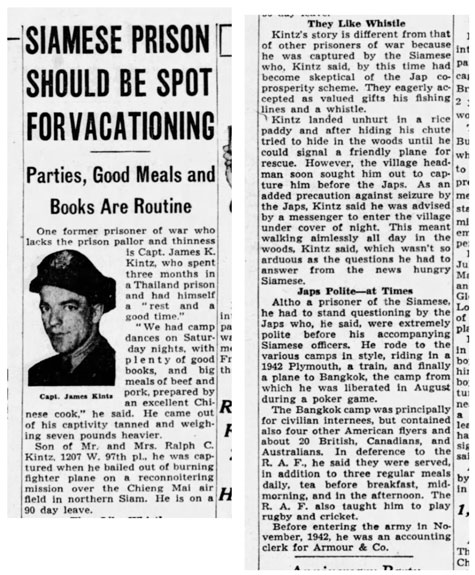 Kintz died, aged 57, as an assistant manager of the Chicago Tribute Credit Department. His obituary does not mention his experiences in the military. 15
Kintz died, aged 57, as an assistant manager of the Chicago Tribute Credit Department. His obituary does not mention his experiences in the military. 15
Locating the crash site: The location of Kintz’s crash site had long been a puzzle. The MACR provided frustratingly vague information about it. There did exist at that time a candidate: a P-38 crash site unidentified in Wiang Haeng. 16 Also possible was that the crash site remained undiscovered, somewhere north of Chiang Mai — perhaps even into Burma.
As noted above, in mid-September 2020, a librarian at Chiang Mai University Library pointed out a recently published book on local history, Chiangmai 60th Anniversary: Past, Present, and Future. 17 It included a selection of entries from a diary maintained by a Chiang Mai resident, Pastor Meungjai Chaninpan, which covered the WWII period. Key in the diary was an entry for 28 May 1945 which mentioned an aircraft crash the previous day north of Chiang Mai in บานหนองปลาทัน (Ban Nong Plaman, spelling per RTSD map) involving a US pilot. My translator, Wiyada Kantarod, was familiar with Nong Plaman, which was just north of Mae Rim, and indeed it shows up on a Royal Thai Survey Department map, as shown below along with the Kintz crash site which was subsequently located: 18
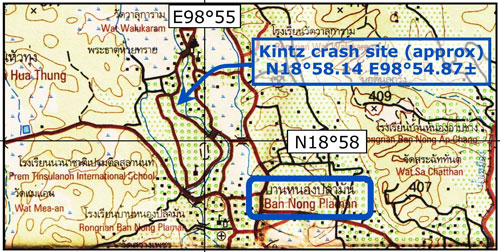 “[A]bout ten minutes” into the return flight from that day’s target, which had been Lampang, Kintz started a descent from 10,000 feet to get a closer view of Chiang Mai, over which they would pass, and assess the damage from the previous day’s bombing there. Chaninpan’s diary recalled that, after bombing Lampang that day, the flight had returned to Chiang Mai to fire on the airport. That might have been his misunderstanding: the pilot, Kintz, had only wanted to observe the airport. 19
“[A]bout ten minutes” into the return flight from that day’s target, which had been Lampang, Kintz started a descent from 10,000 feet to get a closer view of Chiang Mai, over which they would pass, and assess the damage from the previous day’s bombing there. Chaninpan’s diary recalled that, after bombing Lampang that day, the flight had returned to Chiang Mai to fire on the airport. That might have been his misunderstanding: the pilot, Kintz, had only wanted to observe the airport. 19
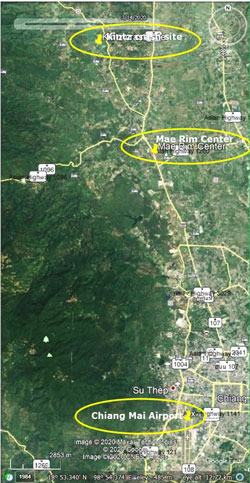 On 10 Dec 2020, we visited Ban Nong Plaman, about seven km NNW of downtown Mae Rim, and found three people confirming that there had been a crash somewhat west of the village; the last, an 80-year-old, identified our source, Mr Mongkone Jantanoy, 20 who proved to be the son of the owner of the paddies where Kintz’s plane had crashed. Mr Mongkone was knowledgeable and talkative. Born well after the crash, he is now in his 60s and had been told about it by his father. The wreckage had been cleared immediately after the crash. In the years after, he had helped his father farm the paddies and continued to work them for some time after his father’s death; but thirty years ago he had sold the land to become part of the Prem Tinsulanonda International School, which opened in 2001.
On 10 Dec 2020, we visited Ban Nong Plaman, about seven km NNW of downtown Mae Rim, and found three people confirming that there had been a crash somewhat west of the village; the last, an 80-year-old, identified our source, Mr Mongkone Jantanoy, 20 who proved to be the son of the owner of the paddies where Kintz’s plane had crashed. Mr Mongkone was knowledgeable and talkative. Born well after the crash, he is now in his 60s and had been told about it by his father. The wreckage had been cleared immediately after the crash. In the years after, he had helped his father farm the paddies and continued to work them for some time after his father’s death; but thirty years ago he had sold the land to become part of the Prem Tinsulanonda International School, which opened in 2001.
As so often in Thailand, the development of the property completely re-sculpted the landscape so that landmarks of even thirty years ago are long lost. Our source was known to security personnel at the school and was able to roam the property freely, with us following. He pointed out where the paddies had been, overgrown by a forest of rain trees on the perimeter of what is now an athletic field. In this photo, the site is beyond the tree line and approximately behind the sign to the right of our source, Mr Mongkone: 21
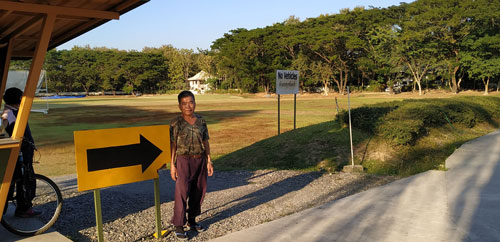 The location of the crash site is estimated as N18°58.14 E98°54.87: 22
The location of the crash site is estimated as N18°58.14 E98°54.87: 22
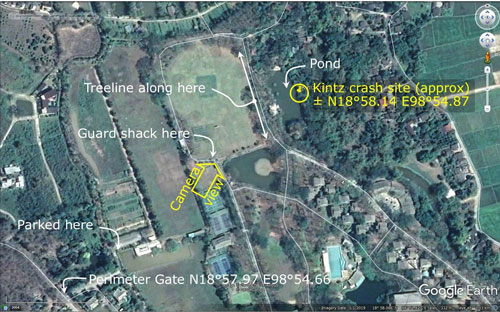 There is a small reservoir immediately to the west of that area; thus the site may now be submerged.
There is a small reservoir immediately to the west of that area; thus the site may now be submerged.
Additional References:
This event is not covered by either Shores or Umemoto.
| First published on Internet | ||
| Links updated | ||
Last Updated on 23 February 2025
- Coordinates for Myitkyina East field: N25°21.43 E97°27.20 Photo: Lockheed P-38H-5-LO 061019-F-1234P-005.jpg.[↩]
- Chicago Tribune, 14 Jan 1945, p 110[↩]
- Extract from USAAF Principal Air Operations for 26 May [1945], (USAF Archive Reel A8202, p 096[↩]
- Extract from Google Maps; annotated with Microsoft Publisher by author, followed by extract from USAAF Principal Air Operations for 26, 27 May [1945], (USAF Archive Reel A8202 p 095).[↩]
- MACR 14589 dated 28 Jun 1944, provided by Dan Jackson per email of 1019 31 Jul 2018. The first three pages of the five page report follow. All five pages are available at Supplemental pages on this website.[↩]
- MACR 14589, page 2.[↩]
- MACR 14589, page 3.[↩]
- สมโชติ อ๋องสกุล, เชียงใหม่ 60 รอบนักษัตร: อดีต ปัจจุบัน และอนาคต (เชียงใหม่: สำนักงานพัฒนาพิงคนคร (องค์การมหาชน), 2020), 155 [Somchote Ongsakul, Chiangmai 60th Anniversary: Past, Present, and Future (Chiangmai: Pinkanakaun Development Office (Public Organization), 2020), p 155] (The book was brought to my attention in mid-Sep 2020 by a librarian at Chiang Mai University Library) [↩]
- Translation by Wiyada Kantarod wth Sakpinit Promthep.[↩]
- Provided from Royal Thai Air Force Museum Archive by Sakpinit Promthep via emails of 1530 01 Feb 2021 and 1407 13 Mar 2021. Entire 8 page letter is available here[↩]
- Translation by Wiyada Kantarod with Sakpinit Promthep.[↩]
- This apparently occurred before the interrogation session with the Japanese.[↩]
- Chicago South End Reporter, 18 Jul 1945, p 1.[↩]
- Chicago Tribune Sun, 30 Dec 1945, p 14[↩]
- Chicago Homewood Flossmoor Star, 29 May 1977, p 6[↩]
- This was subsequently identified as the fatal crash site of 2LT Anthony H Greco.[↩]
- Somchote Ongsakul, Chiangmai 60th Anniversary: Past, Present, and Future, ibid.[↩]
- Excerpt from จังหวัดเชียงใหม่ [Changwat Chiang Mai], 4746 I, Series L7018S, Edition 1-RTSD., with note, “Map Information as of 2007”.[↩]
- Extract from Google Maps; annotated with Microsoft Publisher by author. [A11/Gen locatn.jpg] [↩]
- Mongkone Jantanoy, 415 Moo 2 Ban Nong Pla Man Huai Sai Subdistrict, Mae Rim District, Chiang Mai นายมงคล จันทร์ตาน้อย 415 หมูี่่่่ 2 บ้านหนองปลามัน ตำบลห้วยทราย อำเภอแม่ริม เชียงใหม่[↩]
- IMG_20201210 162808z.jpg looking northeast, by author.[↩]
- Extract from Google Maps; annotated with Microsoft Publisher by author. [A11/Photo positn.jpg][↩]
